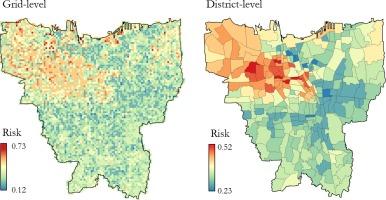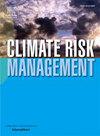利用机器学习从卫星图像评估气候风险:雅加达洪水风险案例研究
IF 5
2区 环境科学与生态学
Q1 ENVIRONMENTAL SCIENCES
引用次数: 0
摘要
对气候风险进行一致而及时的评估,对于在地方社区层面规划减灾和适应气候变化至关重要。本文介绍了一种利用机器学习监测卫星图像气候风险的自动化方法,特别针对河流和沿海洪水。我们的研究表明,与灾害相关的风险测量包括以下组成部分:危害、风险暴露和脆弱性,从而变得更加全面和多面。我们的模型首先利用地理空间数据绘制与灾害相关的风险地图,然后扩展模型,将风险暴露和脆弱性纳入其中。在此过程中,我们采用基于聚类的监督算法对卫星图像进行排序,从而得出网格级的气候风险分数。开发的模型在印度尼西亚雅加达地区的多个洪水风险地面实况数据集上进行了测试。结果证实,我们的模型可以评估细粒度的气候风险,并进一步捕捉到以前难以预测的边缘化地区(如贫民窟)的潜在风险。我们将讨论像我们这样的计算方法如何支持发展中国家的人道主义项目。本文章由计算机程序翻译,如有差异,请以英文原文为准。

Assessing climate risks from satellite imagery with machine learning: A case study of flood risks in Jakarta
Consistent and timely assessment of climate risks is crucial for planning disaster mitigation and adaptation to climate change at the local community level. This article presents an automatized method for monitoring climate risks with machine learning on satellite imagery, specially targeting riverine and coastal floods. Our research demonstrates that disaster-related risk measurement becomes more comprehensive and multi-faceted by including the following components: hazards, exposure, and vulnerability. Our model first maps hazard-related risks with geo-spatial data, then extends the model to incorporate exposure and vulnerability. In doing so, we adopt a clustering-based supervised algorithm to sort satellite images to produce the climate risk scores at a grid-level. The developed model was tested over multiple ground-truth datasets on flood risks in the region of Jakarta, Indonesia. Results confirm that our model can assess climate risks in a granular scale and further capture potential risks in the marginalized areas (e.g., slums) that were previously hard to predict. We discuss how computational methods like ours can support humanitarian projects for developing countries.
求助全文
通过发布文献求助,成功后即可免费获取论文全文。
去求助
来源期刊

Climate Risk Management
Earth and Planetary Sciences-Atmospheric Science
CiteScore
8.20
自引率
4.50%
发文量
76
审稿时长
30 weeks
期刊介绍:
Climate Risk Management publishes original scientific contributions, state-of-the-art reviews and reports of practical experience on the use of knowledge and information regarding the consequences of climate variability and climate change in decision and policy making on climate change responses from the near- to long-term.
The concept of climate risk management refers to activities and methods that are used by individuals, organizations, and institutions to facilitate climate-resilient decision-making. Its objective is to promote sustainable development by maximizing the beneficial impacts of climate change responses and minimizing negative impacts across the full spectrum of geographies and sectors that are potentially affected by the changing climate.
 求助内容:
求助内容: 应助结果提醒方式:
应助结果提醒方式:


